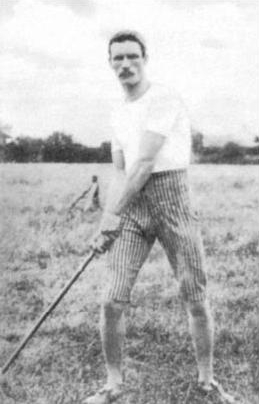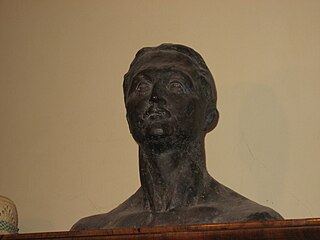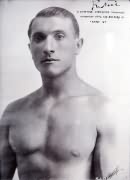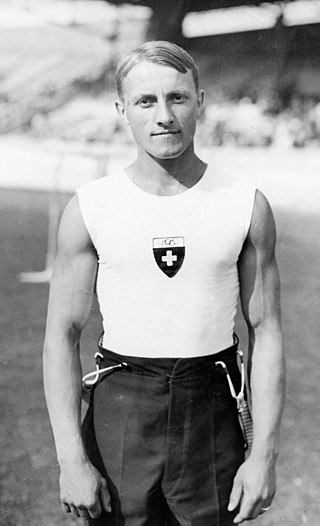
The decathlon is a combined event in athletics consisting of ten track and field events. The word "decathlon" was formed, in analogy to the word "pentathlon", from Greek δέκα and ἄθλος. Events are held over two consecutive days and the winners are determined by the combined performance in all. Performance is judged on a points system in each event, not by the position achieved. The decathlon is contested mainly by male athletes, while female athletes typically compete in the heptathlon.

The 1904 Summer Olympics were an international multi-sport event held in St. Louis, Missouri, United States, from 29 August to 3 September 1904, as part of an extended sports program lasting from 1 July to 23 November 1904, located at what is now known as Francis Field on the campus of Washington University in St. Louis. This was the first time that the Olympic Games were held outside Europe.
At the 1904 Summer Olympics in St. Louis, six archery events were contested, of which three were men's and three were women's competitions. 23 men and 6 women constituted the field. As was common in early Olympic archery, the events held in 1904 had little resemblance to the previous edition's events. The events were essentially United States national championships: formally named the 26th Grand Annual Target Meeting of the National Archery Association and, while open to international entrants, having no foreign competitors. Team archery was introduced at these Games, as was women's archery. The medalists were the same for both men's individual events and both women's individual events. Howell finished with three golds as she was a member of the only women's team to appear.
At the 1904 Summer Olympics, two golf events were contested – men's individual and team tournaments. The competitions were held from September 17, 1904 to September 24, 1904. It was the second and final appearance of the sport at the Olympics until the 2016 Summer Olympics. The men's individual event was switched to a match play tournament rather than the stroke play used four years earlier.

At the 1904 Summer Olympics of St. Louis, Missouri, eleven gymnastics events were contested for the first time.

Francis Olympic Field is a stadium at Washington University in St. Louis that was used as the main venue for the 1904 Summer Olympics. It is currently used by the university's track and field, cross country, football, and soccer teams. It is located in St. Louis County, Missouri on the far western edge of the university's Danforth Campus. Built in time for the Louisiana Purchase Exposition, the stadium once had a 19,000-person seating capacity, but stadium renovations in 1984 reduced the capacity to 3,300 people. It is one of the oldest sports venues west of the Mississippi River that is still in use. Francis Olympic Field now uses artificial turf that can be configured for both soccer and football.

George Louis Eyser was a German-American gymnast who competed in the 1904 Summer Olympics, earning six medals in one day, including three gold and two silver medals. Eyser competed with a wooden prosthesis for a left leg, having lost his leg after being run over by a train. Despite his disability, he won gold in the vault, an event which then included a jump over a long horse without aid of a springboard.

Early Olympic Games allowed for individuals in a team to be from different nations. The International Olympic Committee (IOC) now groups their results together under the mixed team designation. During the 1904 Summer Olympics four teams comprising international members won medals in different events.

Thomas Francis Kiely was an Irish athlete. Kiely won gold in the all-round at the 1904 Summer Olympics in St. Louis, Missouri, making him the first multi-event track and field champion of the Modern Olympic Games

The men's marathon at the 1904 Summer Olympics in St. Louis, United States, took place on August 30 of that year, over a distance of 24.85 miles (40 km).

The men's pole vault was a track and field athletics event held as part of the Athletics at the 1904 Summer Olympics programme. It was the third time the event was held. Seven pole vaulters from two nations participated. The competition was held on Saturday, September 3, 1904. The event was won by Charles Dvorak of the United States, the nation's third consecutive victory in the event. With six of the seven vaulters, the United States swept the top three places—the first time that occurred in the pole vault, though the Americans had never had more than two vaulters compete previously. Through the 1904 Games, no American pole vaulter had ever placed lower than any non-American vaulter.
The men's triathlon was an unusual event conducted during the 1904 Summer Olympics. The International Olympic Committee lists it as part of the Athletics at the 1904 Summer Olympics programme, though other sources list it among the Gymnastics at the 1904 Summer Olympics events. Gymnasts rather than track and field athletes competed. However, the three events of the triathlon were decidedly athletic rather than gymnastic in nature, comprising the long jump, the shot put, and the 100 yard dash.

The men's vault was an artistic gymnastics event held as part of the gymnastics at the 1904 Summer Olympics programme. It was only the second time that the event was held at the Olympics. An unknown number of gymnasts competed, only five are known. The competition was held on Friday, October 28, 1904.
The men's triathlon was an artistic gymnastics event held as part of the Gymnastics at the 1904 Summer Olympics programme. It was the only time the event was held at the Olympics. The competition was held on Friday, July 1, 1904, and on Saturday, July 2, 1904. One hundred and nineteen gymnasts from three nations competed.

The men's artistic individual all-around was an artistic gymnastics event held as part of the Gymnastics at the 1904 Summer Olympics programme. It was the second time an all-around event was held at the Olympics. The competition was held on Friday, July 1, 1904 and on Saturday, July 2, 1904. One hundred and nineteen gymnasts from three nations competed. The event was won by Julius Lenhart, an Austrian gymnast living in the United States and competing under the auspices of his Philadelphia-based club. Silver went to Wilhelm Weber of Germany, with bronze to Adolf Spinnler of Switzerland. They were the first medals in the event for each of those nations, as France had swept the medals in 1900.
The men's team was an artistic gymnastics event held as part of the Gymnastics at the 1904 Summer Olympics programme. It was the first time a team event, in the sense of combining scores of individual gymnasts, was held at the Olympics. Previous team events had been performances by large groups of gymnasts at a single time. The competition was held on Friday, July 1, 1904 and on Saturday, July 2, 1904.

Dr. Béla Elemér Mező was a Hungarian track and field athlete who competed at the 1904 Summer Olympics.

The men's artistic individual all-around event was part of the gymnastics programme at the 1924 Summer Olympics. It was one of nine gymnastics events and it was contested for the sixth time. The competition was held from Thursday, 17 July 1924, to Wednesday, 23 July 1924. Seventy-two gymnasts from nine nations competed. Each nation could send up to 8 gymnasts, up from 6 in previous Games. For the first time since 1904, the scores for individual competitors were used to calculate a team score. The men's artistic individual all-around was won by Leon Štukelj of Yugoslavia. Czechoslovakia's Robert Pražák took silver, while Bedřich Šupčík earned bronze. Both nations were making their debut in the event.

The men's artistic individual all-around event was part of the gymnastics programme at the 1932 Summer Olympics. It was the eighth appearance of the event, which was established in 1900. The competition was held from Monday, August 8, 1932, to Wednesday, August 10, 1932. Twenty-four gymnasts from five nations competed. Each nation could enter a team of 5 gymnasts; Hungary sent only 4. The event was won by Romeo Neri of Italy, the nation's first victory in the event since 1920 and fourth overall. István Pelle of Hungary took silver and Heikki Savolainen of Finland earned bronze; it was the first medal in the event for each nation.

The men's artistic individual all-around event was part of the gymnastics programme at the 1928 Summer Olympics. It was one of seven gymnastics events for men and was the seventh Olympic men's all-around gymnastic championship. Scores from the individual apparatus events were added to give aggregate scores for the individual all-around; individual all-around scores were similarly summed for the team all-around event. There were 88 competitors from 11 nations. Each nation sent a team of 8 gymnasts. The event was won by Georges Miez of Switzerland, with his countryman Hermann Hänggi taking silver. They were the first medals in the event for Swiss gymnasts since 1904 and the first gold medal ever for a Swiss man in the individual all-around. Defending Olympic champion Leon Štukelj of Yugoslavia finished with the bronze this time, making him the third man to win multiple medals in the event.












